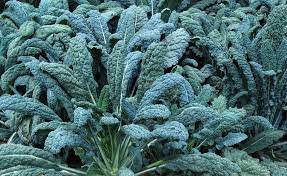Lacinato kale, often referred to as "dinosaur kale" due to its unique appearance, is a versatile and hardy leafy green that thrives in various climates. If you're a Northern California gardener looking to add a nutritious and flavorful green to your garden, you're in the right place. In this feature, we will explore how to grow Lacinato kale in Northern California, focusing on its ability to withstand cold temperatures, starting from seed in January, its origins, and how it differentiates from other kale varieties. All focused on how kale grows in the Sierra Nevada foothills and surrounding communities.
The Hardy Nature of Lacinato Kale
Lacinato kale, scientifically known as Brassica oleracea var. palmifolia, is known for its remarkable ability to withstand cold temperatures. This feature makes it a perfect choice for Northern California, where winters can be chilly... Its hardy nature allows it to thrive even in the cooler months, providing you with a year-round source of fresh greens.
One of the reasons behind Lacinato kale's cold tolerance is its sturdy, blue-green leaves. These leaves are crinkled, giving them a unique texture and appearance that resembles dinosaur skin, hence the nickname "dinosaur kale." This crinkled structure helps the plant retain heat and moisture, making it better equipped to endure colder conditions compared to other kale varieties.
Starting Kale from Seed in January
January is a perfect time to begin your kale-growing journey. Here's a step-by-step summary on how to get started. For more detail, see our video on Growing Kale.
-
Gather Your Supplies: You'll need Lacinato kale seeds, seed trays or pots, potting soil, a spray bottle, and a sunny indoor location or greenhouse. You can purchase all of the needed supplies with our Seed Starting Kit.
-
Prepare the Soil: Fill your seed trays or pots with a high-quality potting mix. Ensure it is well-draining to prevent waterlogged roots.
-
Plant the Seeds: Plant the Lacinato kale seeds about half an inch deep, spacing them 2-3 inches apart. Water the soil gently using a spray bottle to avoid disturbing the seeds.
-
Provide Adequate Light: Place your seed trays or pots in a sunny location or under grow lights. Kale thrives in full sun but can tolerate partial shade.
-
Maintain Moisture: Keep the soil consistently moist but not waterlogged. Be sure to water from the bottom to prevent fungal issues.
-
Thin Seedlings: Once your kale seedlings have two true leaves, thin them out to provide adequate space for growth. Leave the healthiest and strongest seedlings.
-
Transplant Outdoors: When the seedlings are around 4-6 inches tall and the risk of frost has passed (typically in late February or early March depending on your exact climate), transplant them into your garden or raised beds.
The Origin and Unique Characteristics
Lacinato kale has its origins in Italy, particularly in the Tuscany region. It has been grown for centuries and is a staple in Italian cuisine. Its scientific name, Brassica oleracea var. palmifolia, reflects its botanical relationship with other cruciferous vegetables like broccoli and cauliflower.
One of the most intriguing aspects of Lacinato kale is its distinctive appearance. The leaves are long and narrow, with a dark, almost black-green hue. The deep ridges and crinkles give it a textured look, reminiscent of dinosaur skin, hence the popular nickname. This unique appearance not only sets it apart from other kale varieties but also makes it a visually appealing addition to any garden.
Differentiating Lacinato Kale from Other Varieties
While kale, in general, is known for its health benefits and versatility, Lacinato kale offers a distinct set of characteristics that differentiate it from other kale varieties:
-
Texture: The crinkled texture of Lacinato kale leaves sets it apart. Other kale varieties, like curly kale, have more frilly and curly leaves.
-
Flavor: Lacinato kale has a milder, sweeter flavor compared to its counterparts. Its leaves are tender and less bitter, making it a favorite for salads and sautéing.
-
Nutrition: Like all kale varieties, Lacinato kale is packed with nutrients, including vitamins A, C, and K, as well as minerals like calcium and iron.
-
Versatility: Lacinato kale is incredibly versatile in the kitchen. You can use it in salads, smoothies, soups, stir-fries, or as a nutritious addition to your favorite dishes.
Cultivating Kale in the Sierra Nevada Foothills
Northern California offers a wide range of microclimates, including areas with moderate altitudes like the Sierra Nevada foothills. Growing Lacinato kale in these regions requires some specific considerations:
-
Altitude: Kale can thrive at moderate altitudes in the Sierra Nevada foothills, typically up to 2,000 to 4,000 feet. Ensure you choose a location with well-drained soil and good sunlight exposure.
-
Temperature: While Lacinato kale is cold-hardy, it may still experience chilly nights in the Sierra Nevada foothills. Consider using row covers or cloths to protect your plants during cold snaps.
-
Watering: Adequate watering is crucial, especially during dry periods. Mulching around the plants can help retain moisture in the soil.
-
Harvesting: Kale can be harvested throughout the year, but it's essential not to strip the plant completely. Leave a few leaves on each plant to encourage continuous growth.
Growing Lacinato kale in Northern California, including the Sierra Nevada foothills, is a rewarding endeavor. This hardy and nutritious green can thrive even in cold temperatures, making it a valuable addition to your garden. Starting from seed in January provides you with a head start, ensuring a steady supply of fresh kale. Its unique appearance, mild flavor, and versatility in the kitchen make Lacinato kale a favorite among kale enthusiasts. Whether you're a seasoned gardener or a beginner, cultivating Lacinato kale is a delightful way to embrace healthy and sustainable eating habits while enjoying the pleasures of gardening.
For more information, see our kale seeds for sale.

